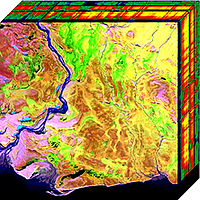
Photo from wikipedia
Mainstream numerical methods for 3D time-domain airborne electromagnetic (AEM) modeling, such as the finite-difference (FDTD) or finite-element (FETD) methods, are quite mature. However, these methods have limitations in terms of… Click to show full abstract
Mainstream numerical methods for 3D time-domain airborne electromagnetic (AEM) modeling, such as the finite-difference (FDTD) or finite-element (FETD) methods, are quite mature. However, these methods have limitations in terms of their ability to handle complex geologic structures and their dependence on quality meshing of the earth model. We have developed a time-domain spectral-element (SETD) method based on the mixed-order spectral-element (SE) approach for space discretization and the backward Euler (BE) approach for time discretization. The mixed-order SE approach can contribute an accurate result by increasing the order of polynomials and suppress spurious solutions. The BE method is an unconditionally stable technique without limitations on time steps. To deal with the rapid variation of the fields close to the AEM transmitting loop, we separate a secondary field from the primary field and simulate the secondary field only, for which the primary field is calculated in advance. To obtain a block diagonal mass matrix and hence minimize the number of nonzero elements in the system of equations to be solved, we apply Gauss-Lobatto-Legendre integral techniques of reduced order. A direct solver is then adopted for the system of equations, which allows for efficient treatment of the multiple AEM sources. To check the accuracy of our SETD algorithm, we compare our results with the semianalytical solution for a layered earth model. Then, we analyze the modeling accuracy and efficiency for different 3D models using deformed physical meshes and compare them against results from 3D FETD codes, to further show the flexibility of SETD for AEM forward modeling.
Journal Title: GEOPHYSICS
Year Published: 2019
Link to full text (if available)
Share on Social Media: Sign Up to like & get
recommendations!